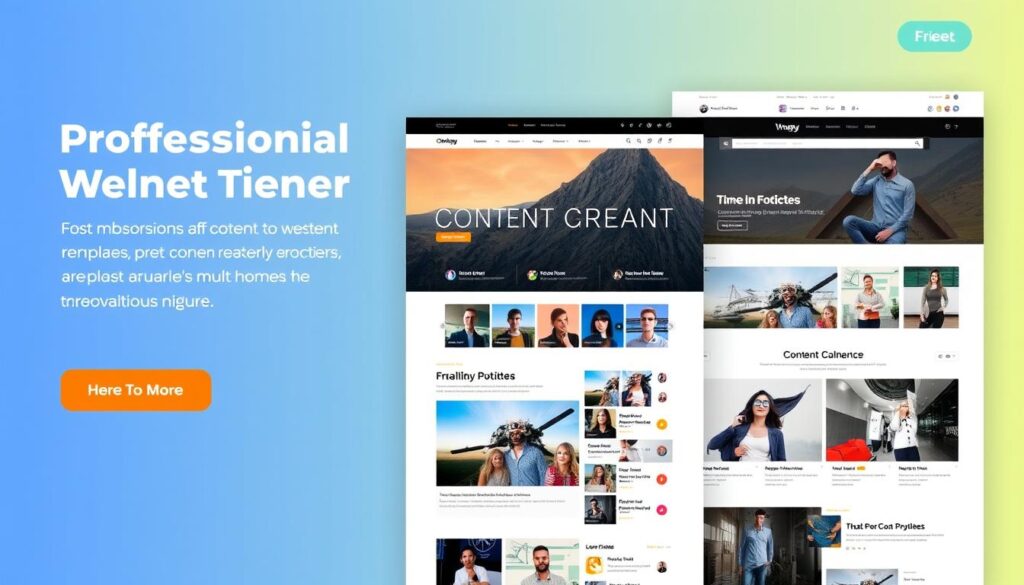In today’s digital landscape, high-quality content is crucial for a successful website content creation strategy. It’s the foundation upon which effective digital marketing strategies are built, enabling businesses to engage their target audience and drive growth.
We’re here to help you streamline your content development process, ensuring it resonates with your audience and supports your overall marketing strategy. By focusing on creating compelling content, you can enhance your brand visibility, improve search engine rankings, and ultimately boost business growth.
Effective content is key to delivering an engaging user experience. By understanding your content goals and developing a tailored content production plan, you can save time, resources, and frustration while attracting and converting visitors into loyal customers.
Key Takeaways
- Crafting a content strategy that aligns with your marketing goals
- Understanding the importance of quality content for engaging user experiences
- Developing a content production plan to save time and resources
- Creating content that attracts and converts visitors into loyal customers
- Measuring performance and refining your content strategy
The Power of Quality Website Content
In today’s digital landscape, the importance of quality website content cannot be overstated. As we navigate the complexities of online engagement, it becomes clear that content is at the heart of any successful digital strategy. It’s not just about filling pages with words; it’s about creating a meaningful connection with your audience.

What is Website Content Creation?
Website content creation is a strategic process that involves developing, organizing, and publishing valuable material on your website to engage visitors and achieve business objectives. This content can take many forms, including written text, images, videos, infographics, and interactive elements, all working together to create a cohesive user experience. For more insights on website content, you can visit our comprehensive guide on website content.
- Developing content that resonates with your target audience
- Organizing content to enhance user experience
- Publishing content that drives engagement and conversions
Why Content is Central to Your Digital Strategy
Quality content serves as the foundation for establishing trust with your audience and positioning your brand as an authority in your industry. It directly impacts your search engine rankings, as search engines like Google evaluate content quality to determine where your website appears in search results. By investing in content creation, you’re not just filling pages—you’re building a long-term digital strategy that drives business results.
Effective content creation helps differentiate your business from competitors and creates a unique brand voice in a crowded digital landscape. It’s about creating meaningful connections with your audience that drive engagement and conversions, ultimately contributing to the success of your online presence.
Understanding Your Content Goals
Establishing clear content goals is the foundation upon which a successful content strategy is built. To create effective content, you must first define what you want to achieve with your content. This involves understanding your business objectives and how your content can support them.

Aligning Content with Business Objectives
Your content should serve a purpose that aligns with your overall business strategy. Whether your goal is to increase sales, build brand awareness, or establish thought leadership, your content should be designed to achieve these objectives. For instance, if you’re an eCommerce retailer, your content will focus on product descriptions, photos, and videos that showcase your products and drive transactions. In contrast, a business consulting firm will create content that highlights their expertise and results.
We’ll guide you through establishing clear content goals that align with your business objectives. This includes setting SMART content goals (Specific, Measurable, Achievable, Relevant, Time-bound) that give direction to your content creation efforts. By doing so, you’ll be able to measure the success of your content and make data-driven decisions.
Identifying Your Target Audience
Understanding your target audience is crucial for creating content that resonates with them. This involves conducting audience research to create detailed buyer personas that inform your content creation process. By knowing your audience’s needs, preferences, and pain points, you can create content that speaks directly to them.
We’ll show you how to conduct audience research and gather insights through analytics, surveys, and direct feedback. This will help you continuously refine your understanding of what your audience needs and create content that meets those needs.
By aligning your content with your business objectives and understanding your target audience, you’ll be able to create a content strategy that drives results and supports your overall business goals.
Elements of Effective Website Content Creation

Effective website content creation is an art that balances information, engagement, and optimization to captivate your target audience. As we delve into the core elements that make website content truly effective, it’s essential to understand that the goal is not just to provide information but to deliver value to your readers.
Value-Driven Content Development
Value-driven content development prioritizes solving problems for your audience. It’s about creating content that goes beyond basic information to provide comprehensive context, examples, and actionable insights that readers can immediately apply. By focusing on the needs and pain points of your audience, you can develop content that resonates with them and fosters a loyal following.
SEO-Optimized Content
SEO-optimized content is crucial for increasing your website’s visibility on search engines. This involves conducting thorough keyword research, optimizing on-page elements like headings and meta descriptions, and creating content that satisfies search intent. By incorporating SEO best practices into your content creation process, you can improve your website’s ranking and drive more organic traffic to your site.
Content That Builds Trust and Authority
Building trust and establishing authority in your industry are critical outcomes of effective content creation. This can be achieved by incorporating data, expert opinions, case studies, and testimonials into your content. Consistency in voice, quality, and publishing schedule also plays a significant role in establishing your brand as a trusted and authoritative source. By doing so, you not only maintain reader trust but also drive business results through enhanced credibility and authority.
By focusing on these elements, you can create a robust content strategy that not only engages your audience but also supports your business objectives. Whether it’s through value-driven development, SEO optimization, or building trust and authority, the key is to deliver high-quality, relevant content that meets the needs of your audience and sets your website apart in the digital landscape.
Building a 7-Step Content Production Plan
A 7-step content production plan can help you organize your content creation process from start to finish. This plan is not a one-size-fits-all solution but is tailored to guide each type of content through the production process, ensuring consistency and quality.
To start, we need to lay the groundwork for our content production plan. This involves several key steps that help us manage our content workflow effectively.
Developing Content Governing Resources
We begin by developing content governing resources such as style guides and editorial guidelines. These resources ensure that our content is consistent across all platforms and creators. A style guide outlines the tone, voice, and language usage for our brand, while editorial guidelines provide direction on content structure and formatting.
Identifying Content Formats
Next, we identify the most effective content formats for our specific business goals and audience preferences. This could include blog posts, videos, interactive tools, or other types of content that resonate with our target audience. By understanding what works best for our audience, we can tailor our content strategy to meet their needs.
Mapping Content Processes
We then map out detailed processes for each content type, creating repeatable workflows that increase efficiency and maintain quality standards. This involves outlining every stage of the content creation process, from ideation to publication, and identifying the resources needed at each stage.
Assigning Team Roles
Assigning team roles based on skills and strengths is crucial for effective content production. Whether we’re working with in-house staff, freelancers, or a combination of both, we need to ensure that each team member understands their responsibilities and is equipped to deliver high-quality content.
Establishing Timelines
Establishing realistic timelines and deadlines for each stage of the content production process is vital. This includes accounting for review cycles and revisions to ensure that our content meets the required standards.
Automating Workflow
To streamline our content production process, we explore workflow automation tools and techniques that reduce manual tasks and improve collaboration between team members. Automation can help us save time and focus on creating high-quality content.
Creating Content Inventory Systems
Finally, we create content inventory systems that organize and track all our content assets for easy access and management. This enables us to maintain a centralized repository of our content and make informed decisions about future content creation.
By following these 7 steps, we can develop a comprehensive content production plan that enhances our content creation process and helps us achieve our business goals.
Content Creation Strategies for Different Website Elements
To maximize the potential of your website, it’s essential to develop content strategies that cater to the unique needs of various website elements. A website serves as a centralized hub for content creators, tying together social media profiles, blogs, products, and more. Effective content creation is crucial for driving conversions and enhancing user experience across different sections of your website.
Homepage Content That Converts
Your homepage is often the first point of contact for visitors, making it crucial to clearly communicate your value proposition. To drive conversions, focus on creating concise, compelling content that highlights your unique selling points and includes clear calls to action.
- Clearly state your brand’s mission and value proposition.
- Use compelling visuals to capture visitors’ attention.
- Include prominent calls to action to guide visitors toward conversion points.
Product and Service Pages
For product and service pages, the goal is to provide detailed information that addresses potential objections and highlights benefits. Use a mix of descriptive content, customer testimonials, and clear calls to action to guide visitors toward purchase decisions.
- Highlight the key benefits and features of your products or services.
- Address common objections with FAQs or detailed descriptions.
- Use customer testimonials to build trust and credibility.
About Page and Brand Storytelling
Your “About” page is an opportunity to tell your brand story and build emotional connections with your audience. Craft an authentic narrative that resonates with your target audience and highlights your brand’s unique attributes.
- Share your brand’s history and mission.
- Highlight what sets your brand apart from competitors.
- Use storytelling techniques to create an emotional connection with your audience.
Blog Content Strategy
A well-planned blog content strategy supports your overall marketing goals while addressing your audience’s information needs. Focus on creating high-quality, relevant content that is optimized for search engines and provides value to your readers.
- Develop a content calendar to plan and organize your blog posts.
- Use keyword research to optimize your content for search engines.
- Create content that addresses the needs and interests of your target audience.
Content Production Process Examples
A well-structured content production process enables teams to produce high-quality content efficiently. In this section, we’ll explore examples of content production processes for different content types, including blog posts, social media content, and webpage content.
Blog Post Production Workflow
The blog post production workflow involves several key steps. First, we create a content brief and outline for each blog post. The writer then develops the content according to the Style Guide and submits it for review. The editor reviews the content, requests revisions if necessary, and conducts a final review, including SEO optimization. Once the content is approved by the stakeholder, it’s ready for publication.
Here’s an example of a blog post production workflow table:
| Step | Description | Responsible |
|---|---|---|
| 1 | Create content brief and outline | Content Team |
| 2 | Write content | Writer |
| 3 | Review and revise content | Editor |
| 4 | Final review and SEO | Editor |
| 5 | Publish content | Stakeholder |
Social Media Content Creation
For social media content creation, we follow a step-by-step process that includes planning, creation, approval, scheduling, and performance analysis. We plan content in advance using a content calendar, create engaging content that aligns with our brand voice, and obtain approval from stakeholders before scheduling the content for publication.
Webpage Content Development
Webpage content development involves a comprehensive workflow that accounts for both content creation and technical implementation considerations. We develop content that is optimized for search engines and user experience, ensuring that it meets our quality standards.
By following these content production process examples, teams can create high-quality content that resonates with their target audience and drives business results.
Common Content Creation Mistakes to Avoid
In the realm of digital marketing, content is king, but its effectiveness can be undermined by common mistakes. When creating content, it’s easy to fall into traps that can dilute your message, confuse your audience, and ultimately harm your marketing efforts. Understanding these pitfalls is crucial to developing a successful content strategy.
Writing for Everyone Instead of Someone
One of the most significant content creation mistakes is writing for a broad, general audience instead of targeting specific segments. When you try to appeal to everyone, your content often resonates with no one. Tailoring your content to a specific audience leads to higher engagement, sharing, and conversion rates. By understanding your target audience’s needs and preferences, you can create content that speaks directly to them.
Changing Too Many Elements at Once
Another common mistake is making too many changes to your content strategy simultaneously. This can confuse your audience and make it challenging to determine what’s working and what’s not. It’s essential to make incremental changes and monitor their impact on your audience’s engagement and conversion rates. By doing so, you can refine your content strategy effectively.
Neglecting Content Distribution Channels
Neglecting content distribution channels is a critical oversight. Creating great content is only half the battle; you must also ensure it reaches your target audience through the right channels. Developing a distribution strategy before creating content is vital to maximizing its impact. This includes leveraging social media, email newsletters, and other platforms to get your content in front of the right people.
Essential Tools for Website Content Creation
Effective website content creation hinges on leveraging the best tools available to manage, create, and optimize your content. In today’s digital landscape, numerous tools can streamline and enhance your content creation process.
Content Planning and Management Tools
Content planning and management are crucial for organizing your content calendar and workflow. Tools like CoSchedule, Trello, Asana, and Monday.com help teams coordinate content production and maintain publishing schedules.
Writing and Editing Tools
To improve content quality and collaboration, utilize powerful writing and editing tools such as Grammarly, Hemingway Editor, and Google Docs. These tools help refine your writing and ensure clarity.
Visual Content Creation Tools
Visual content is essential for engaging your audience. Tools like Canva, Adobe Creative Suite, and Piktochart enable you to create professional graphics without needing advanced design skills.
By integrating these tools into your content creation process, you can enhance your website’s content and improve your overall marketing strategy. Whether you’re focusing on SEO optimization or creating engaging blog posts, the right tools are essential for success.
Content Creation Ideas for Inspiration
In a digital landscape flooded with content, standing out requires creativity. With an estimated 1.14 billion websites worldwide, each containing hundreds or thousands of pieces of content, the challenge is real. However, your brand’s unique perspective is the key to creating compelling, original content that drives results.
To inspire your content strategy, we will explore several innovative ideas. These include addressing common customer questions, creating educational content, celebrating brand achievements, leveraging trending topics, and repurposing successful content.
Answering Common Customer Questions
Addressing frequently asked questions not only demonstrates your expertise but also provides value to your audience. By understanding their pain points, you can tailor your content to offer meaningful solutions, thereby establishing your brand as a trusted resource. For instance, creating a comprehensive FAQ section on your website or blog can serve as a valuable resource for your audience.
Educational Content That Teaches Your Audience
Developing educational content that imparts valuable skills or knowledge related to your industry positions your brand as a helpful authority. This can be achieved through tutorials, webinars, or informative articles that cater to the needs and interests of your audience.
Celebrating Brand Achievements
Celebrating milestones and achievements through content humanizes your brand and fosters emotional connections with your audience. It’s an effective way to share your brand’s story and values.
Trending Topics in Your Industry
Identifying and leveraging trending topics allows you to create timely, relevant content that captures audience interest. Staying abreast of industry trends is crucial for maintaining a competitive edge.
Repurposing Successful Content
Repurposing successful content across different formats and platforms maximizes its value. This strategy ensures that your best-performing content continues to engage your audience in various ways.
Measuring Content Performance
Measuring content performance is a critical step in achieving our digital goals. By assessing how our content is performing, we can refine our content strategy to better engage our audience and drive desired outcomes.
To effectively measure content performance, we need to identify and track the right metrics. This involves understanding what each metric reveals about our content’s effectiveness and how it aligns with our overall SEO and content objectives.
Key Metrics to Track
Several key metrics are essential for understanding content performance. These include traffic, engagement rates, time on page, bounce rates, conversions, and social shares. Each of these metrics provides insights into how our audience interacts with our content and whether it is meeting our goals.
- Traffic indicates the number of visitors to our site or specific pages.
- Engagement rates show how actively our audience is interacting with our content.
- Time on page and bounce rates help us understand whether our content is holding our audience’s attention.
- Conversions measure the success of our content in driving desired actions.
- Social shares indicate the value and relevance of our content to our audience.
Tools for Content Analytics
To track these metrics effectively, we utilize specialized analytics tools. Google Analytics is a powerful tool that provides comprehensive insights into our website’s traffic, engagement, and conversion data. Other tools can offer additional insights into specific aspects of content performance, such as social media engagement and content optimization opportunities.
Using Data to Refine Your Content Strategy
Once we have collected and analyzed our content performance data, we can use these insights to refine our content strategy. This involves identifying successful approaches and areas for improvement, adjusting our content types and distribution channels, and continually monitoring performance to ensure we are meeting our goals.
By leveraging data-driven insights, we can optimize our content to better resonate with our audience, improve our SEO efforts, and ultimately drive more traffic and conversions through our blog and other content channels.
Creating a Content Hub for Content Creators
In today’s digital landscape, a content hub serves as a vital tool for creators to centralize their content and expand their reach. A well-designed website is crucial for content creators to showcase their work, promote their products and services, and connect with their audience.

Essential Website Elements for Content Creators
For content creators, certain website elements are indispensable. These include a portfolio section to display their best work, a media kit for potential collaborators, an about page to share their story, and contact information for business inquiries. By incorporating these elements, creators can establish credibility with their audience and potential clients.
Integrating Social Media with Your Website
To create a seamless experience across platforms, content creators should integrate their social media profiles with their website. This can be achieved through embedded feeds, social sharing buttons, and cross-promotion techniques. By doing so, creators can drive traffic to their blog and other content, enhancing their overall online presence.
By following these strategies and utilizing a content creator website template, you can develop a robust content hub that effectively promotes your content and engages your audience.
Conclusion
As we wrap up our comprehensive guide on professional website content creation, it’s clear that a well-crafted content strategy is pivotal for digital success. Throughout this guide, we’ve explored the multifaceted nature of creating engaging website content that not only resonates with your audience but also drives meaningful business outcomes.
A strategic approach to content creation is essential, aligning with broader business goals and delivering measurable results beyond just website traffic. Understanding your audience deeply and creating content that specifically addresses their needs, questions, and challenges is crucial. This involves developing a systematic content production process that ensures consistency and scalability as your content efforts grow.
Content creation is an ongoing journey that requires continuous refinement based on performance data and changing audience preferences. It’s essential to implement the strategies, tools, and frameworks shared in this guide in ways that make sense for your specific business context and resources. Moreover, staying adaptable in an evolving digital landscape is vital, with emerging trends in website content creation continually shaping the way we approach content marketing.
To achieve success, it’s crucial to balance creativity with strategy, creating content that not only ranks well in search engines but genuinely connects with people. By doing so, you can drive meaningful business outcomes and establish a strong brand presence online. As you move forward, we encourage you to leverage the insights and strategies outlined in this guide to enhance your content strategy and propel your digital success.






